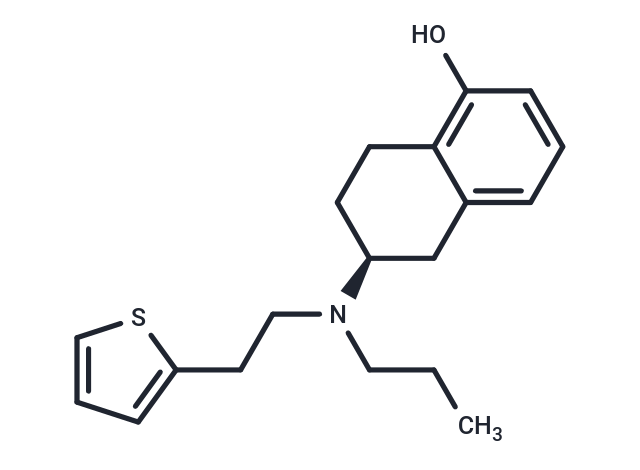Shopping Cart
- Remove All
 Your shopping cart is currently empty
Your shopping cart is currently empty

Rotigotine (N-0923) is a non-ergot dopamine receptor agonist used in the therapy of Parkinson disease and restless leg syndrome. Administered as a once-daily transdermal patch, Rotigotine has not been associated with serum enzyme elevations during treatment or with episodes of clinically apparent liver injury.

| Pack Size | Price | Availability | Quantity |
|---|---|---|---|
| 5 mg | $48 | In Stock | |
| 10 mg | $71 | In Stock | |
| 25 mg | $148 | In Stock | |
| 50 mg | $268 | In Stock | |
| 100 mg | $397 | In Stock | |
| 200 mg | $582 | In Stock | |
| 500 mg | $913 | In Stock | |
| 1 mL x 10 mM (in DMSO) | $50 | In Stock |
| Description | Rotigotine (N-0923) is a non-ergot dopamine receptor agonist used in the therapy of Parkinson disease and restless leg syndrome. Administered as a once-daily transdermal patch, Rotigotine has not been associated with serum enzyme elevations during treatment or with episodes of clinically apparent liver injury. |
| Targets&IC50 | 5-HT7 receptor:86 nM (Ki), D1 receptor:83 nM (Ki), D4 receptor:4-15 nM (Ki), D3 receptor:0.71 nM (Ki), 5-HT1A receptor:30 nM (Ki), D5 receptor:4-15 nM (Ki), D2 receptor:4-15 nM (Ki) |
| In vitro | The selectivity of Rotigotine for D3 (pKi 9.2) receptors is higher 10-fold than D2/D4/D5 (pKi 8.5-8.0) and 100-fold than D1 receptors (pKi 7.2). Rotigotine (10 μM) decreases the number of THir neurons by 40% in primary mesencephalic cell culture. In functional studies, Rotigotine behaves as a full agonist at all dopamine receptors but notably, the potency for stimulation of D1 receptors is similar to that for D2/D3 receptors (pEC50 respectively: 9.0, 9.4-8.6, 9.7). Rotigotine (0.01 μM) slightly protects dopaminergic neurons against MPP+ toxicity, significantly protects dopaminergic neurons against rotenone-induced cell death, and significantly inhibits ROS production by rotenone. |
| In vivo | In primed rats, Rotigotine (0.035/0.1/0.35 mg/kg) dose-dependently induces contralateral turning behavior. In drug-naive rats, the turning behavior induced by Rotigotine, either alone or in combination with SCH 39166, is reduced compared to primed rats. |
| Kinase Assay | Binding assays are performed in 96-well polypropylene tubes in a final volume of 2?mL for D1 and D4 membranes and 1?mL for D2, D3 and D5 membranes containing: 50?μL radioligand, 10?μL drug/buffer/non-specific binding, buffer (final concentration 50?mM Tris-HCl pH 7.4, MgCl2 2?mM) and membranes (5?μg protein for D2 and D3 and 25?μg protein for D1 and D5). Following 120?min of incubation at 25°C, bound radioligand is determined by rapid vacuum filtration through A/C glass fibre filters presoaked in 0.1% polyethylenimine. The filters are washed four times with 2?mL ice-cold ishing buffer (Tris-HCl 50?mM, pH?7.4 at 4°C) and retained radioactivity is determined by liquid scintillation counting. |
| Alias | SPM 962, Neupro, N-0923, N-0437 |
| Molecular Weight | 315.47 |
| Formula | C19H25NOS |
| Cas No. | 99755-59-6 |
| Smiles | OC1=C2C(C[C@@H](N(CCC3=CC=CS3)CCC)CC2)=CC=C1 |
| Relative Density. | 1.15 g/cm3 (Predicted) |
| Storage | Powder: -20°C for 3 years | In solvent: -80°C for 1 year | Shipping with blue ice. | |||||||||||||||||||||||||||||||||||
| Solubility Information | H2O: < 1 mg/mL (insoluble or slightly soluble) DMSO: 75 mg/mL (237.74 mM), Sonication is recommended. Ethanol: 59 mg/mL (187.02 mM), Sonication is recommended. | |||||||||||||||||||||||||||||||||||
Solution Preparation Table | ||||||||||||||||||||||||||||||||||||
Ethanol/DMSO
| ||||||||||||||||||||||||||||||||||||

Copyright © 2015-2025 TargetMol Chemicals Inc. All Rights Reserved.